Telemedicine or telehealth is the provisioning of medical or health care over a distance via some type of information communication technology (i.e., teleconferencing systems, computers, tablets, mobile phones, etc.). [i]
Telemedicine has been around since the 1950’s (the term was coined in the 1970’s) yet has never fully taken hold. Telemedicine services have long been promoted as a way to increase access to health care for those who might not have the clinical services in their area. Specifically, this has been seen as a way to provide access to specialized care or provide remote management support to those with chronic conditions. At the same time there have been limitations in deployment because of infrastructure, both technologically and of our health care system including, licensing, payment, prescribing, and privacy regulations. (A notable exception in the U.S. health care system is the Veterans Health Administration.)
There are also questions about acceptance, from the perspective of both providers and of patients. In my research with colleagues, I have found that patients, in general, are more accepting of telemedicine and have rated the visits as highly satisfactory. This is to be expected as they are receiving care that they might not have easy access to, have the sole attention of the provider, did not have to travel far distances, and in turn, disrupt work and family obligations. Providers, on the other hand, have been a bit more reluctant to accept telemedicine. Many of the them perceive that their patients won’t like it (although they rarely ask), have concerns about privacy and confidentiality, worry about the communication with the patient, and have issues scheduling and billing for these visits. Although, in research studies, many of these barriers are non-existent, as we are examining the effectiveness of telemedicine on improving health outcomes, and in a sense, have made an artificial environment in order to provide this type of care. Even with the barriers removed, there is still quite a bit of trepidation and low use of the telemedicine services. I posit that this non-adoption is due to the infrastructures of work in a hospital or a clinic. This is why there has been an increase in doctors who just practice over telemedicine.
Additionally, up until recently telemedicine was carried out using whole room teleconferencing equipment in a hospital or clinic setting. Now many health care systems and insurers provide access to telemedicine services using the patient’s own equipment (e.g., cell phone, laptop, etc.).
Now that the novel coronavirus (COVID-19) has been deemed as a pandemic by the World Health Organization,[ii] telemedicine is being recommended for those who think they have symptoms to consult with a health care provider, in order to protect both other patients and providers. Additionally, the insurance companies are being more liberal in the reimbursement or payment of these services,[iii] which provides an interesting opportunity to see how telemedicine performs and the expectations we should set on this method of providing health care into the future.
I believe that this current public health crisis will finally demonstrate if telemedicine has turned the corner as a practical and safe way to deliver and receive routine care. There is going to be such a push from the public to have and be able to continue to use this type of service that I would expect it to become a standard of care for many.
I’m seeking to further understand this trend and hope to report on
my findings later.
[i] https://www.who.int/goe/publications/goe_telemedicine_2010.pdf
[ii] https://www.npr.org/sections/goatsandsoda/2020/03/11/814474930/coronavirus-covid-19-is-now-officially-a-pandemic-who-says
[iii] https://www.cms.gov/newsroom/press-releases/president-trump-expands-telehealth-benefits-medicare-beneficiaries-during-covid-19-outbreak
Whitten, P., Holtz, B., & Nguyen, L. (2010). Keys to a Successful and Sustainable
Telemedicine Program. International Journal of Technology Assessment in Health Care, 26(2):211-216. doi:10.1017/S026646231000005X.
Whitten, P., Holtz, B., & LaPlante, C. (2010). Telemedicine: What Have We Learned? Applied Clinical Informatics, 1(2):132-141. doi: 10.4338/ACI-2009-12-R-0020.
Whitten, P., Holtz, B., Meyer, E., & Nazione, S. (2009). Telehospice: Reasons for Slow Adoption in Home Hospice Care. Journal of Telemedicine and Telecare, 15(4):187-190. doi:10.1258/jtt.2009.08091.1
Whitten, P., Holtz, B., & Nazione, S. (2009). Searching for Barriers to Adoption of the Videophone in Hospice Setting. Journal of Technology in Human Services, 27(4):307-322. doi:10.1080/15228830903329849.
Whitten, P. & Holtz, B. (2008). Provider Utilization of Telemedicine: The Elephant in the Room.
Telemedicine and e-Health, 14(9):995-997. doi: 10.1089/tmj.2008.0126.
